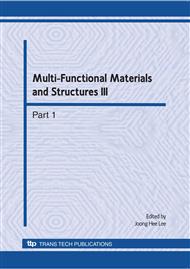p.1175
p.1179
p.1183
p.1187
p.1191
p.1195
p.1199
p.1203
p.1207
Study of Characteristic of Vetiver Fiber Before and after Alkaline Treatment
Abstract:
In this study, untreated and alkali-treated vetiver fibers were characterized by thermogravimetric analysis, BET surface analysis, X-ray diffraction and FTIR (ATR) microspectroscopy,. It was revealed that the alkaline treatment influenced properties of vetiver fiber. By the treatment, some hemicellulose and lignin were removed, resulting in higher decomposition temperatures. In addition, the specific surface area were decreased, and crystalline structure was altered. However, no evidence of changes in surface functional groups was observed.
Info:
Periodical:
Pages:
1191-1194
Citation:
Online since:
August 2010
Keywords:
Price:
Сopyright:
© 2010 Trans Tech Publications Ltd. All Rights Reserved
Share:
Citation:


